Mount Kenya is the second highest mountain in Africa and offers breath-taking hikes suitable for adventurers with a range of abilities. When climbing Mount Kenya, preparation is the key to your success.
Below we have provided a summary of useful information that you will want to read before you go. These are our most frequently asked questions about climbing Mount Kenya.
Climbing Mount Kenya- The Basics
Where is Mount Kenya?
Located in Kenya, equatorial Africa, Mount Kenya boasts the second highest point on the continent and stands at an impressive 5,199m (17,057ft) tall. The main peaks rise from about the 4,500m mark to the summit of Batian (5199m), Nelion (5188m) and Lenana (4985m) amongst others.
To hike this mountain, travellers generally fly into Kenya's capital city of Nairobi. There are multiple international flight options to Jomo Kenyatta International Airport (NBO). Generally, tour operators collect guests from Nairobi and drive to Mt. Kenya National Park by road.
Why Climb Mount Kenya?
This natural wonder is often overlooked by potential travellers in favour of the taller African alternative, Mount Kilimanjaro. However, many experienced hikers report that they preferred Mount Kenya because of the thriving wildlife and idyllic mountain lakes it has to offer.
It is also much more off-the-beaten path. With snow-covered peaks and panoramic views of its forested slopes and the surrounding African planes, hiking Mount Kenya promises the adventure of a lifetime.
Hikers can expect to pass through distinctive zones characterized by a variety of vegetation. Gentle farmlands give way to dense rain forest which is populated by camphors and several species of monkeys, buffalo, elephant and even leopard.
As hikers ascend, they will encounter a belt of natural, homogenous bamboo followed by a region of low-lying shrubbery. Finally, the altitude becomes inhabitable for flora and fauna, yielding a barren moonscape of jagged rock and ice. These eroded, volcanic slopes are 3 million years old, and present a challenging and awe-inspiring final push.
Choosing the right path is essential to a successful hiking experience, and the different peaks of Mount Kenya provide options suited for the casual fit trekker as well as for advanced technical climbers. Of the highest peaks, point Lenana alone can be reached without technical climbing experience, but there are numerous routes to get to this point. From the base to summit generally takes from three to five days.
To help you make the right choice of route, and to help you prepare for this unique journey, we have compiled a comprehensive overview of all you need to make this experience the best it can be.
Join a Mt Kenya Hike
Book with our recommended local guide
Mount Kenya Routes
There are 8 main trekking routes on Mount Kenya, all of which summit the lowest peak, Point Lenana at 4,985 metres (16,355 ft). The majority of the 15,000 annual visitors to the mountain go on to summit the lower peak, but for those with technical climbing skills, the second peak Nelion and highest point Batian, are there for the taking too.
Hikers usually choose different routes for their ascent and descents, the most common combinations being the Sirimon-Chogoria (six or seven days) and the Sirimon-Naro Moru (five days) options.
These lesser-used routes require special permission from the Kenya Wildlife Service: the Burguret Route, the Timau Route, the Meru Route and the Kamweti Route.
Best Mt. Kenya Routes For Beginners
Below is a summary of the most popular routes to point Lenana, the highest point that can be reached without advanced rock-climbing.
Naro Moru Route (4 days)
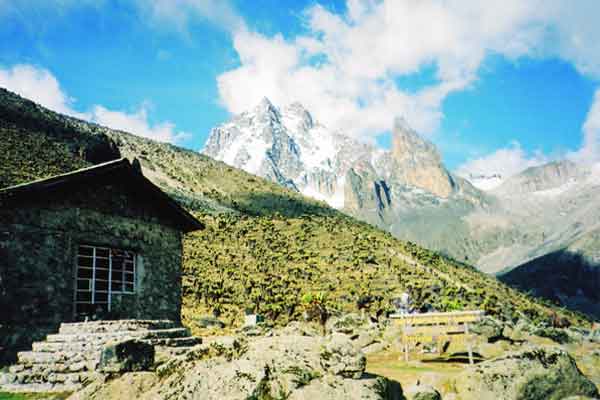
This is the most popular and fastest route to Point Lenana, but can often be overcrowded with hikers. It also does not pass through some of the more scenic regions of the mountain.
The ascent generally takes only three days and there are bunkhouses available along the route for overnight accommodation.
The terrain is mostly manageable, but it includes the “Vertical bog”, a steep and challenging marshy area. Otherwise, this route passes through the wide Teleki Valley with a striking view of the Tyndall glacier.
Ascent on the Naro Moru route:
- Day 1*: Nairobi to Met Station ( 3 to 4 hours)
- Day 2: Met Station to MacKinder’s Camp (5 to 6 hours)
- Day 3: MacKinder’s Camp to Point Lenana and descent to Met Station (8 to 10 hours)
* One day at Naro Moru River Lodge, or another base camp is recommended for acclimatization
Chogoria Route (5 days)
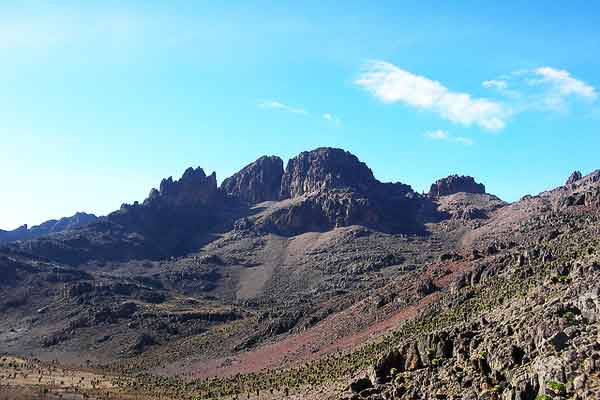
Photo by Joxean Koret
This is perhaps the most scenically beautiful of the routes featured on this guide to climbing Mount Kenya. It is, however, the longest, requiring approximately four days from bottom to top. The trail starts from Chogoria town.
It includes spectacular views of Lake Michaelson from a sheer cliff known as the “Temple”, as well as a long walk along the Gorges Valley.
Sirimon Route (4/5 days)
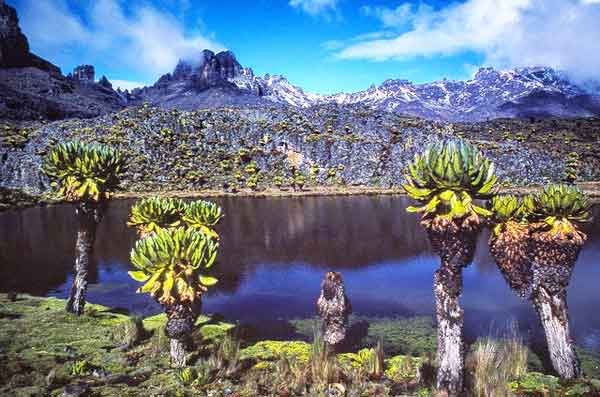
Photo by Ray in Manila
This is definitely the most off-the-beaten path and physically manageable route on the northern side of the central peaks and takes three to four days from base to summit.
It is the driest region, avoiding much of the rainfall which falls on the mountain experience. Nevertheless, drinking water is ample and there is always enough to refill bottles.
The route passes through unique, wildlife-filled, yellowwood forests which give way directly to moorland – the bamboo forest is not present on this part of the mountain.
Typical Itinerary for casual hiking to Point Lenana – Sirimon via Chogoria traverse:
This is a typical itinerary for the combination of the two most scenic routes, Sirimon via Chogoria, and includes one mandatory camping night.
- Day 0 (Optional): Arrival from Nairobi, day at Base lodge
- Day 1: Arrival from Nairobi, enter through Sirimon Park gate. Hike through forest and bamboo (3 – 4 hours) and arrive for overnight at Old Moses Hut
- Day 2: (May be split into 2 days of hiking): Long trek through moorlands to the base of the peaks (7 hours). Sleep in Shipton’s Hut.
- Day 3: Early morning attempt to summit Point Lenana to watch the sunrise. Descent to Minto’s camp and spend the day resting and exploring the Gorges Valley. Sleep in Minto’s campsite
- Day 4: Gentle descent on the left bank of the Gorges Valley to Meru Mount Kenya Lodge (5 -6 hours)
- Day 5: Walk through the Chogoria Forest to base, where vehicle transfers back to Nairobi or Base Lodge
Hikers usually choose different routes for their ascent and descents, the most common combinations being the Sirimon-Chogoria (6 or 7 days) and the Sirimon-Naro Moru (5 days) options. This allows hikers to see much more of the mountain.
Burguret Route (7 days)

Photo by Ryan G
If you are looking for a more challenging, wild trek, this option might be for you.
Because the Burguret route has only recently been reclaimed from the surrounding forest, the paths are very overgrown and other hikers are few and far between.
The Chogoria route can then be followed down the mountain.
These lesser-used routes for climbing Mount Kenya require special permission from the Kenya Wildlife Service. Check with your tour operator if the fees are included in your quote:
- Burguret Route
- Timau Route the Meru Route
- Kamweti Route
Join a Mt Kenya Hike
Book with our recommended local guide
Advanced Technical Mt Kenya Climbing - Routes
Batian and Nelion are the highest peaks on Mount Kenya and are known to be some of the best technical climbing alpine peaks in the world. There are approximately 35 recorded technical climbing routes on Mount Kenya– this guide will focus on some of the most frequently used, guided technical climbing routes.
Normal route – South Ridge to Nelion
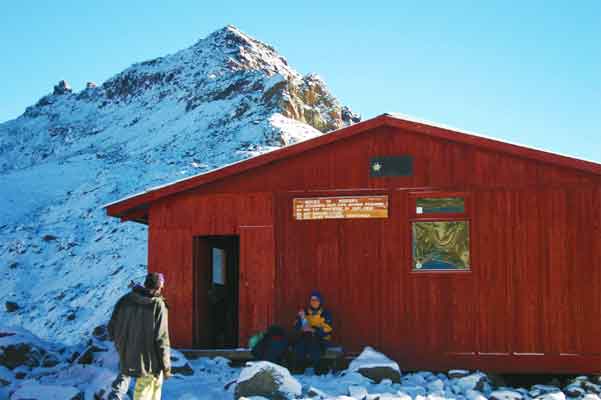
This route is situated on the southern side of Mt Kenya, accessed from the Austrian hut. The hike requires 8 hours of climbing, 18 pitches, 1 overnight camp and a 3-hour descent. Before dawn, the Lewis Glacier is crossed using head torches until you reach the base of the climb.
Once the sun rises, the views become increasingly impressive as you pass the “1-o’clock gully”, “The Amphitheatre” and “De Graf’s Variation” which present areas with a variety of technical difficulty. Nelion is generally summited in about 7 hours and ambitious climbers can extend their expedition by staying overnight in the Howell Hut and then crossing over to Batian via the “Gates of Mist”.
This is option takes an additional 3-4 hours and is dependent on the ice levels in the Gates of Mist. Otherwise, the descent can commence first thing in the morning after a stay over in the Howell Hut.
Typical itinerary for the Normal route to Nelion.
Day 1
Day 2
Day 3
Day 4
Day 5
Day 6
Day 7
Day 8
North Face Standard Route – North Face to Batian
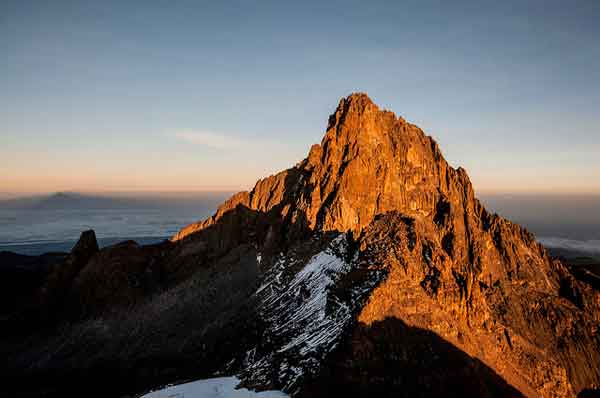
Photo by Francesco Tonnarelli
This advanced climbing route is the most direct to the highest point of Mount Kenya and traverses the northern side of the massif.
This route is more challenging that the “normal” alternative, and requires about 12 hours of climbing, an overnight camp, followed by 5 hours of descent. The climb to the summit normally starts from bivy at the Amphitheatre.
Typical Itinerary for the North Face Route.
Day 1
Day 2
Day 3
Day 4
Day 5
Day 6
Day 7
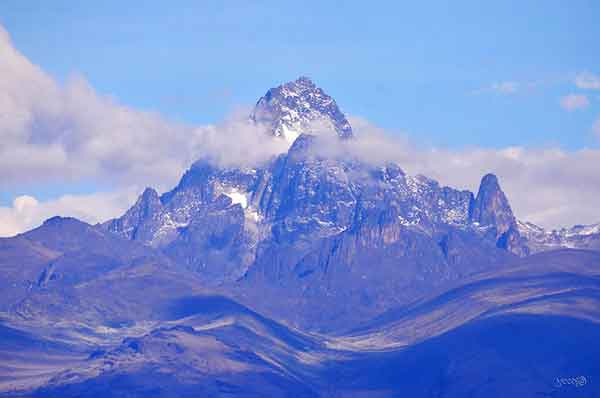
Photo by Yochi23
MT. Kenya FAQs
1. When is the Best Time To Climb Mount Kenya?
The best time for climbing Mount Kenya, with regards to weather, is generally the dry months of January, February, August and September. However, this is also the most popular time so if you prefer solitude to clear weather, you may prefer trekking out of season.
The rainy seasons are typically between March and May and from October to December.
Technical climbing routes depend more on the annual weather conditions than the casual hiking routes do, and so more specific information on the climbing route you have chosen should be used to decide on the time of your visit.
The “Normal route” on the South Ridge to Nelion should be undertaken between December and March, while the “North face Standard route” to Batian is best attempted in July, August and September.
The temperatures on Mount Kenya are relatively constant throughout the year, but change significantly upon ascent, with day temperatures ranging from 15°C to 5°C and night temperatures dropping well below freezing.
Check out our hiking gear list to make sure you are well prepared for whichever conditions are thrown your way.
Join a Mt Kenya Hike
Book with our recommended local guide
How Difficult Is The Mount Kenya Climb?
While Mount Kenya is a tough hike, it is still possible for beginner level hikers to reach Point Lenana (4985m), so long as you have a good level of fitness and endurance. Point Lenana is the easiest of Mt. Kenya's peaks and a straightforward trek. Reaching the slightly higher Batian (5199m) or Nelion (5188m) peaks requires some technical rock climbing skills and shouldn't be attempted by beginners.
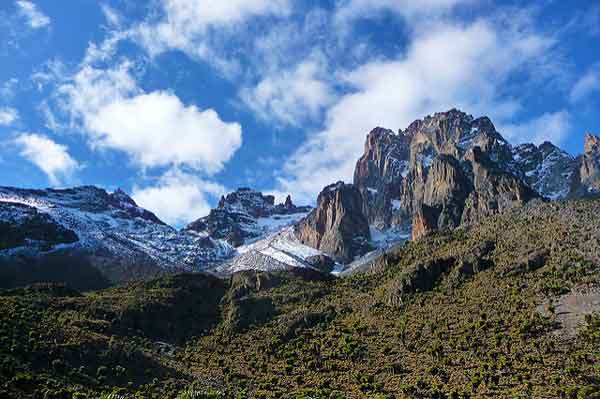
Photo by Yoann Maldonado
The most technically challenging sections of the hiking route to Point Lenana generally only requires a bit of scrambling over snow and ice.
The greatest challenge to trekkers is usually not the physical exertion but the effects of thinning air which are evident above the 3000m mark.
How Fit Do You Need to be to Climb Mount Kenya Technical Routes?
The difficulty of the technical climbs varies, but significant prior climbing experience is essential for all climbing options. Even though you will be accompanied by qualified guides, experience of outdoor multi-pitch climbing is necessary, as well as with leading long runouts, long abseils and applying safety procedures.
The summit of Nelion is reached after one, protracted day of climbing and a series of about 18 pitches, and while the climb is not highly graded technically (between scramble and UIAA IV +, averaging at around UIAA II). The climb up Batian Peak also requires a full day of climbing, and a series of up to 21 pitches. These range from low grade scramble to grade UIAA IV+, averaging around UIAA II.
Apart from the technical grade, there are other considerations which affect the difficulty and safety of the advanced climbs.
Firstly, their significant length demands physical stamina as well as mental concentration over up to 11 hours.
Secondly, while most guided tours facilitate sufficient acclimatization, the altitude of the climbs compound the fatigue experienced by climbers.
Potential tricky weather conditions (which can be mitigated by choosing to hike at the best time of year for the chosen route, and including a “weather day” for insurance), as well as the lack of sophisticated rescue facilities which would be expected in the European Alps, for example are also factors which must be taken into account when determining the difficulty of the trek-climb combination.
Is Altitude Sickness a Risk on Mount Kenya Climb?
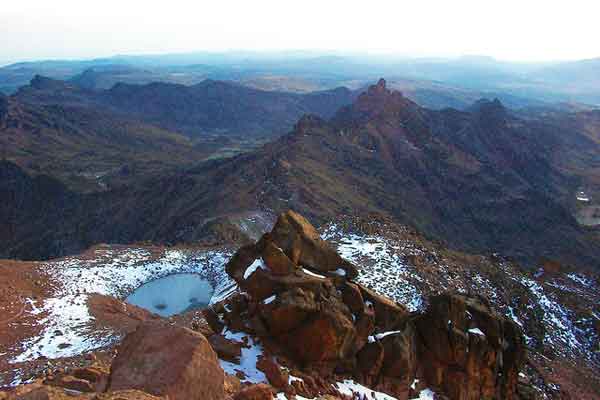
Photo by Joxean Koret
Altitude sickness (or Acute Mountain Sickness (AMS)) is the main obstacle hikers face in reaching the summit.
Head-aches and nausea are its common effects and are experienced by most hikers beyond 3000m. To mitigate these symptoms, it is recommended that hikers drink 3-4 litres of water per day, and acclimatize properly to the thin air.
Before hiking Mount Kenya, it is essential that hikers are fully informed on the risks, symptoms and treatments available for AMS as well as for high altitude pulmonary edema (HAPE) and high altitude cerebral edema (HACE), which are life-threatening if left untreated.
Read our guide on altitude sickness here.
What Gear do I need for Mount Kenya? (Mt. Kenya Packing List)
To help you prepare for your African expedition, have a look at a brief gear check list below.
Thankfully the list is very similar to our Kilimanjaro Packing List, which you are welcome to use for your preparation.
This list is suited for the casual trek only – technical climbing equipment should be sought with the help of your experienced guide and depends on the route you have chosen to climb.
To choose the best gear available today, check out our detailed Gear Reviews & Ranking.
Clothing
- 2 × long/short sleeve shirts (moisture-wicking fabric)
- Warm fleece top
- Soft shell jacket/Hard shell, waterproof jacket (breathable hood)/Down jacket (insulated)
- Thermal base later (long johns and vests, moisture-wicking fabric)/Lightweight poncho
- Waterproof trousers (side zipper recommended)/Hiking trousers/Fleece trousers (for evenings at camp)/Shorts
- 6 × underwear (moisture-wicking fabric)
- Brimmed hat/Knitted beanie/Balaclava or buff
- 2 × gloves/mittens (a warm & a thin, windproof)
- Hiking boots (waterproof, warm, broken-in)/Sandals for campsite
- 4 × pairs of thick wool hiking socks/Thick socks reserved for night times
Gear & Paperwork
- Warm sleeping bag (comfort -5° or lower)
- Sleeping mat (e.g. Therm-A-Rest, check if provided)
- Rucksack (usually carried by porters, 65L - 90L)
- Day bag (for personal carriage and use, 35L - 45L)
- Duffle bag (to leave unneeded items at the base lodge, 80L - 100L)
- Sunglasses (with UV protection)
- 2 × water bottles (Nalgene, 1L), or 1 × Water bladder (Camelback, 3L)
- Pee bottle (1.5L, to avoid having to leave tent at night)
- Collapsible trekking poles
- Head lamp with extra batteries
- A few plastic bags to keep gear dry
- Passport/3 × photocopies of passport/Student card (optional)
- Flight details
- Insurance policy details (see below)
- Yellow fever certificate
- Cash (for tips) and bank cards
Toiletries, First Aid & Other Items
- Facecloth/Travel towel (quick dry)/Wet wipes
- Soap/Hand sanitiser
- Sunscreen (SPF 30+)
- Toilet paper
- Toothbrush & toothpaste
- Insect repellent
- First aid kit
- Anti-malaria tablets
- Pain killers (Ibuprofen and Paracetamol)
- Zinc oxide tape and small scissors
- Pack of blister pads
- Loperamide / Immodium diarrhea tablets
- Pack of Dioralyte sachets (or similar rehydration packs)/Electrolytes, powder or tablets (optional)
- Pack of throat lozenges
- Pack of iodine water purification tablets
- Prescription medication
- Whistle
- Duct tape
- Paperwork
- Waterproof wallet
How Much Does Mount Kenya Climb Cost?
What Permits Do I need?
Generally you need to budget between $2,800 - $5,000 per person to hike Mount Kenya. The cost varies, depending on how long you are planning to spend on the mountain, the time of year you plan on hiking, and the amount of equipment you will need to buy new.
Here is a rough cost break down for your trip up Mount Kenya.
Visa, Vaccinations, Insurance: ~ $400-$550
Equipment (buying and hiring): ~$200-$500
Return flights to Nairobi: ~$1000 – $2,000
Trek package: $800 – $1,500
This varies by operator with local companies offering cheaper packages. Trek packages generally include transport to and from Nairobi, meals, a professional guide, and accommodation for the hiking nights, and the cost of the park permit.
Tips: $100-$150
Miscellaneous (this includes extra accommodation, additional food, and any unplanned expenses): ~ $300
Total costs: $2,800-$5,000
Can I Climb Mount Kenya Without a Guide?
As per regulations by the Kenyan government, solo hikers are not allowed on the mountain. Guides need to be officially registered and hold a KWS (Kenya Wildlife Services) card.
Technically, groups of two or more are still allowed to climb Mount Kenya without a guide (this regulation could and likely will change). However, unless you are a very experienced mountaineer, we strongly suggest hiring a good local guide to safely get you to the summit. A good guide will also add value to your trek with knowledge of the local landscape.
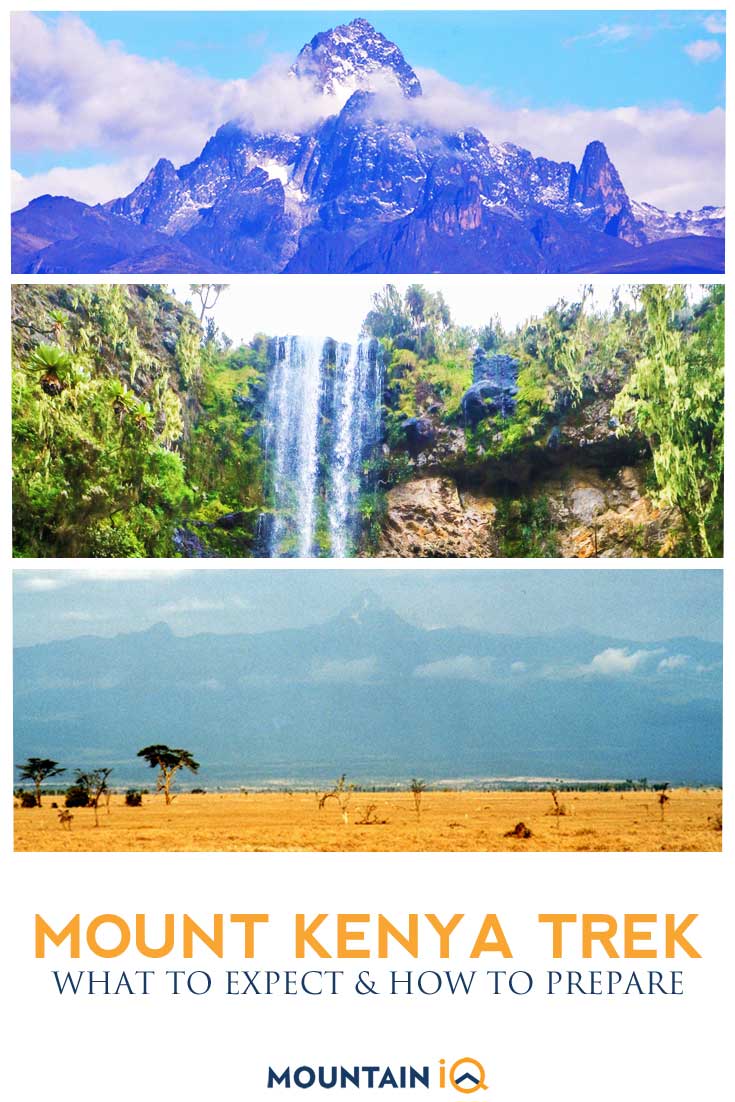


Hi I'm looking to climb to the actual summit of Mt Kenya, can you recommend an appropriate guide or tour operator
Hi Chris, I recommend this local operator: https://www.skyhookadventure.com/trips/mt-kenya
Looking for a trip to climb to Lanana peak Mount Kenya from around the 5th April
Hi Philip, I recommend checking out this trip: https://www.skyhookadventure.com/trips/mt-kenya